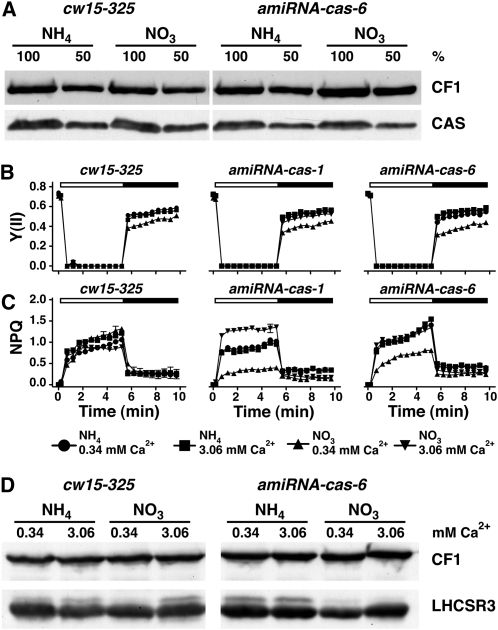Figure 8.
amiRNA-cas-1 and -6 Show Unaltered Fv/Fm Compared with the Wild Type but Diminished NPQ Induction and PSII Recovery, Which Can Be Rescued by Calcium.
(A) Quantification of CAS amounts in thylakoids isolated from the wild type (cw15-325) and amiRNA-cas-6 grown under LL in TAP-NH4 (amiRNA expression repressed) or TAP-NO3 (amiRNA expression activated) upon SDS-PAGE fractionation and immunoblot analysis (100% equals 70 μg of protein per lane; CF1 signal served as loading control). Densitometric analyses showed that CAS levels in amiRNA-cas-6 are reduced by 40% compared with the wild-type levels (in NO3).
(B) and (C) Determination of PSII quantum yield and recovery and NPQ. The wild type, amiRNA-cas-1, and amiRNA-cas-6 were initially shifted from LL TAP-NH4 to LL TAP-NO3 for 40 h to activate the amiRNA expression and subsequently shifted to HL in either HSM-NH4 or HSM-NO3 containing 0.34 or 3.06 mM Ca2+ for 24 h. After 20 min of dark adaptation, the quantum yields of PSII (B) and NPQ (C) were recorded during 5.2 min of illumination at 800 μE m−2 s−1 (white bar) followed by 4.3 min of darkness (black bar), during which recovery of PSII and relaxation of NPQ could be followed. Values plotted are the means of three measurements ± sd.
(D) Quantification of LHCSR3 amounts in the wild type (cw15-325) and amiRNA-cas-6. Cells were initially shifted from LL TAP-NH4 to LL TAP-NO3 for 40 h to activate the amiRNA expression and subsequently shifted to HL in either HSM-NH4 or HSM-NO3 containing 0.34 or 3.06 mM Ca2+ for 24 h. Before exposure to HL, the cultures were set to 2.5 μg chlorophyll/mL. Whole-cell extracts (2.5 μg of chlorophyll) were fractionated on a 13% SDS-PAGE, and LHCSR3 abundance was analyzed by immunoblots. CF1 signal served as a loading control.

